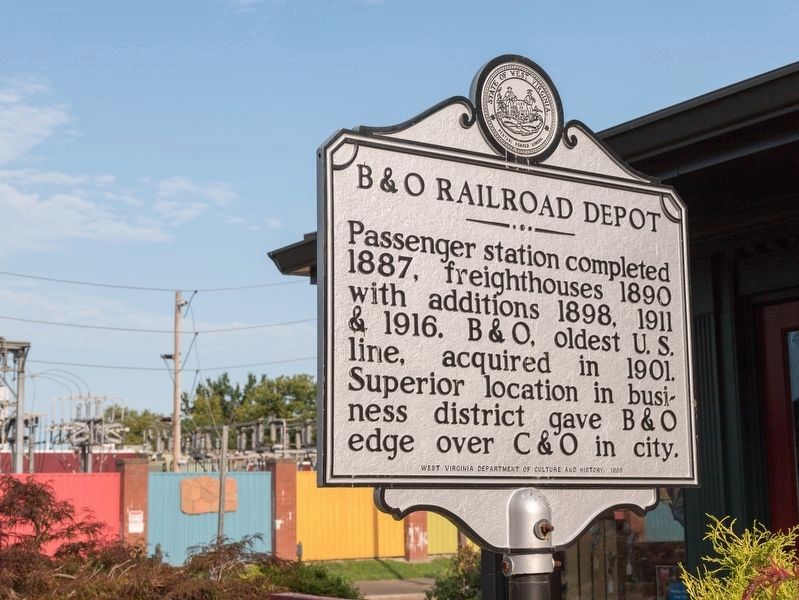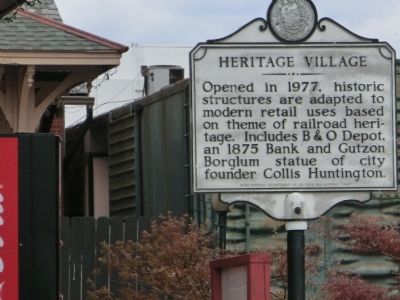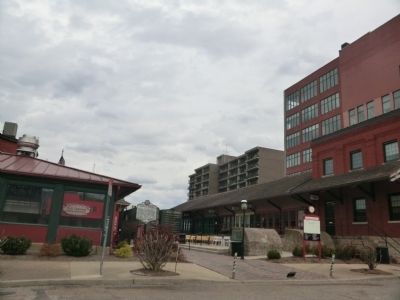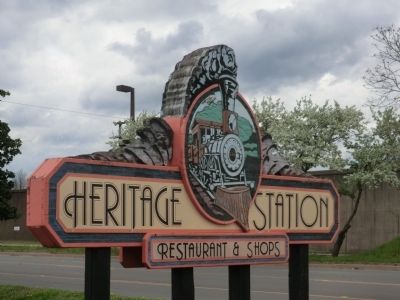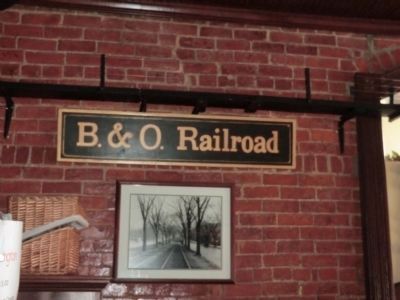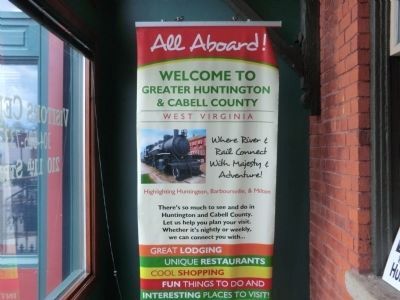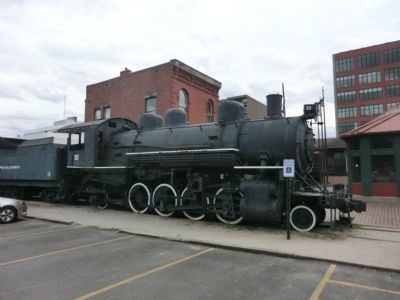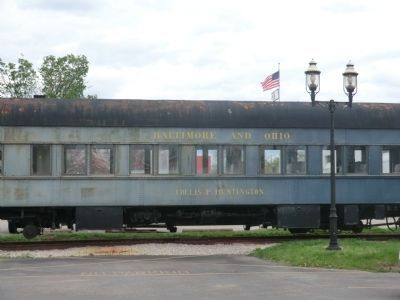Huntington in Cabell County, West Virginia — The American South (Appalachia)
B&O Railroad Depot / Heritage Village
B&O Railroad Depot. Passenger station completed 1887, freighthouses 1890 with additions 1898, 1911 & 1916. B&O, oldest U.S. line, acquired in 1901. Superior location in business district gave B&O edge over C&O in city.
Heritage Village. Opened in 1977, historic structures are adapted to modern retail uses based on theme of railroad heritage. Includes B&O Depot, and 1875 Bank and Gutzon Borglum statue of city founder Collis Huntington.
Erected 1980 by West Virginia Department of Culture and History.
Topics and series. This historical marker is listed in these topic lists: Entertainment • Industry & Commerce • Railroads & Streetcars. In addition, it is included in the Baltimore and Ohio Railroad (B&O), and the West Virginia Archives and History series lists. A significant historical year for this entry is 1977.
Location. 38° 25.402′ N, 82° 26.449′ W. Marker is in Huntington, West Virginia, in Cabell County. Marker is on 11th Street south of Veterans Memorial Boulevard (U.S. 60), on the left when traveling south. Touch for map. Marker is at or near this postal address: 210 11th St, Huntington WV 25701, United States of America. Touch for directions.
Other nearby markers. At least 8 other markers are within walking distance of this marker. “Diamond Teeth” Mary McClain (within shouting distance of this marker); Elk River Coal & Lumber Company #10 Steam Locomotive (within shouting distance of this marker); John Hunt Oley (within shouting distance of this marker); Veterans Memorial (approx. 0.2 miles away); Clinchfield Railroad (approx. 0.2 miles away); Heisler Steam Engine (approx. 0.2 miles away); Frank "Gunner" Gatski Memorial Bridge (approx. 0.2 miles away); Collins P. Huntington (approx. 0.2 miles away). Touch for a list and map of all markers in Huntington.
Additional commentary.
1. About the “superior location” of this depot
This “superior location“ would certainly apply to non-time-critical less-than-a-boxcar freight and package service, which would be picked up by the recipient at the freight depot next to this station. The Chesapeake and Ohio station was further away from downtown than the Baltimore and Ohio station.
But for passenger service, it would depend on where the passenger wanted to go. Departing from either station would get you to any destination in North America eventually, by changing trains en route, but the trip would be significantly shorter and/or more comfortable to certain destinations depending on which station you departed from. Your travel agent knew this and would book you the fastest or more convenient train.
This station was not on B&O’s main line. B&O passenger trains that served this station ran south for a few more miles to the end of the line at Kenova, and north through Parkersburg to Wheeling, and many passenger trains to Wheeling continued on to Pittsburgh PA. At Wheeling and at Pittsburgh, same-line connections could be made to other points in the U.S.
The competition had better long distance service. The C&O station in Huntington was on C&O’s main line from Cincinnati OH to Newport News VA and many C&O trains split in Charlottesville VA so that some of the cars would continue to Washington DC and New York City while the rest of the train continued through Richmond to Newport News.
From this B&O station in 1925, for example, the 10:35 p.m. overnight train would get you to Wheeling at 6:45 a.m., and Pittsburgh at 9:20 a.m. the next day without changing trains. You would have to change trains on the C&O and it would take much longer to get to Wheeling or Pittsburgh. Other trains north left at 7:35 a.m. and 11:40 a.m. to arrive in Wheeling at 4:25 p.m. and 7:20 p.m. respectively. All trains included either a cafe car or a full dining car and the overnight train had at least four sleeping cars.
The C&O had another advantage: direct trains to the state capital, Charleston. B&O tracks did not go to Charleston. But interestingly enough, if you were coming from, say, Wheeling to Charleston and could leave Wheeling at 6:45 a.m., it was faster to take the B&O to Huntington, transfer by cab to the C&O station which was ⅝ of a mile away, and continue to Charleston. You would get there at 7:05 p.m.
— Submitted July 30, 2021, by J. J. Prats of Powell, Ohio.
Credits. This page was last revised on January 12, 2023. It was originally submitted on May 15, 2014, by Don Morfe of Baltimore, Maryland. This page has been viewed 645 times since then and 30 times this year. Last updated on January 4, 2023, by Carl Gordon Moore Jr. of North East, Maryland. Photos: 1. submitted on July 28, 2021, by J. J. Prats of Powell, Ohio. 2, 3, 4, 5, 6, 7, 8, 9. submitted on May 15, 2014, by Don Morfe of Baltimore, Maryland. • Devry Becker Jones was the editor who published this page.
